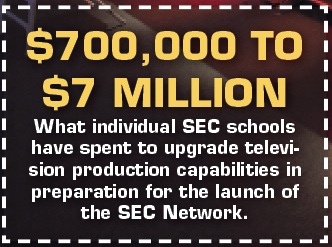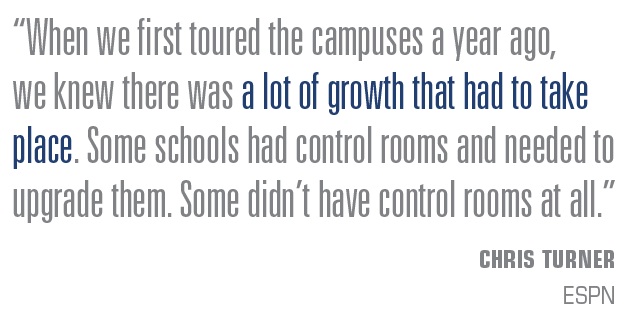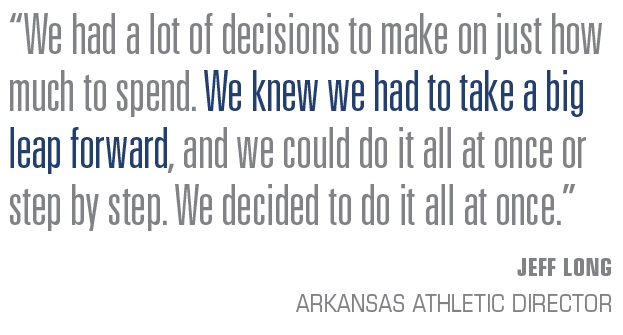A year ago, the bowels of Bud Walton Arena at the University of Arkansas were filled with discarded filing cabinets, band instruments, old computers and merchandise that had been pulled from the shelves. It was an 11,000-square-foot collection area that had been forgotten.
Now, that space represents some of the most vital and expensive square footage on campus. It’s the home of the Razorbacks’ SEC Network operations, where the school has built three control rooms, a half dozen edit bays, multiple studios for audio and replay, and office space for a staff of five producers, graphic designers and engineers.
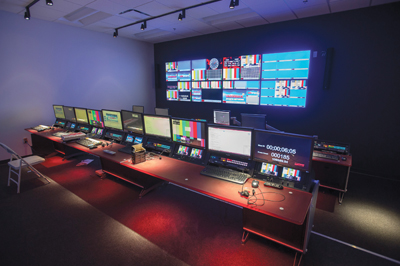 |
Arkansas spent $7 million on equipment and staff, tops among SEC schools. Here is the school’s main production room.
Photo by: University of Arkansas |
What was once throw-away space resembles a thriving production house capable of creating TV-quality, high-definition programming. It also represents the kind of transformation many SEC schools have undergone in the past year to prepare for this week’s launch of the SEC Network.
{podcast}
SBJ Podcast:
College writer Michael Smith and editor Tom Stinson discuss what the SEC Network means to the conference's schools as it gets ready to launch.
On Thursday, the newest conference channel will appear on dials throughout the SEC’s 11-state footprint and beyond. But what viewers won’t fully comprehend right away is the effort and expense required across 14 campuses to get ready for this week.
“When we first toured the campuses a year ago, we knew there was a lot of growth that had to take place,” said Chris Turner, ESPN’s senior director of SEC programming. “Some schools had control rooms and needed to upgrade them. Some didn’t have control rooms at all.”
ESPN’s executives and operations experts began touring SEC campuses last summer shortly after they announced plans to form the SEC Network. Schools were given a set of standards they needed to meet — a minimum of four HD cameras, control rooms with replay capabilities, fiber connectivity to athletic venues, and the ability to produce at least 40 events at TV quality. And they had a year to get ready.
SEC schools cumulatively have spent $25 million to $30 million on their campuses — ranging from $700,000 at
Florida to $7 million at Arkansas, depending on their needs — so they can produce events for the network at TV quality. ESPN’s operations experts, led by Rex Arends and Scott Hecht, worked with the schools, visiting some campuses as many as six times since last summer.
ESPN will still produce the events going on the SEC Network’s linear channel, while the games produced by the schools will go on the network’s digital platforms. But it’s important for the schools to produce a TV-quality event because those games could jump from digital to the linear channel in midstream. In the cases of rainouts, blowouts or blackouts, the TV channel could switch to a game that started on digital, but only if the production is good enough.
“No matter what platform it’s on, TV or digital, we want each broadcast to look like an SEC Network game,” said Justin Connolly, ESPN’s senior vice president of college networks and chief of the SEC Network. “We’d love to be able to switch a game over from digital to the linear channel and still have it look really good.”
In its first year, the SEC Network plans 450 events on the linear channel and 560 on the digital platform. Each university has told ESPN that it plans to do more than the minimum of 40 required by ESPN.
By comparison, the Pac-12 Networks’ multiple channels showed more than 1,200 events on linear TV and digital combined in 2013-14, the second year of the networks.
“It’s amazing to think what has happened in the last 12 months,” Arends said. “It’s hard to look up from your feet right now because we’re about to launch, but even though this feels like the finish line, it’s just the start.”
Extreme makeover: TV edition
The makeover at Arkansas has been among the most extreme. The Razorbacks have spent $7 million to add staff and equipment, and renovate space, all within the past seven months. The athletic department used money from its reserves, so the withdrawal didn’t affect the annual $89 million budget.
The Razorbacks could have spent less and still met ESPN’s requirements, but Athletic Director Jeff Long made the call to build out everything the school needed to create a state-of-the-art production house. These same facilities also will be used to create content on ArkansasRazorbacks.com and run the video boards at each of the Hogs’ athletic venues, so they have multiple purposes.
Other schools, such as Alabama, Florida and Texas A&M, were ahead of their peers and had invested heavily in production facilities two to three years ago, before they knew there was going to be an SEC Network. The Gators, for example, teamed with the journalism school to build a control room so that they could produce content for their website and video boards, while also providing real-life production experience for students. Their upfront costs for the SEC Network were only $700,000.
ESPN’s Arends said 10 of the 14 schools in the SEC were finalizing the construction of new control rooms, or enhancing the ones they already have, in the weeks leading up to the network’s launch. Each school will have the capability to produce two events at once, whether through multiple control rooms or a single control room plus a flypack, which is a mobile control room and can be set up at the venue.
Some additional expenses, like bureau cameras, were mandatory for all 14 schools. The bureau camera is entirely operable from the SEC Network’s headquarters in Charlotte, making it simple to conduct an interview remotely.
ESPN paid for the camera and installation, while the schools paid the expense of constructing the room and making sure it’s connected by fiber to the control room.
Those schools with the most to do, such as Arkansas, Missouri and Vanderbilt, spent anywhere from the low seven
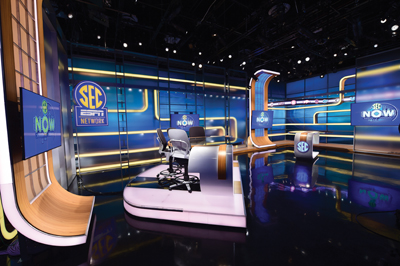 |
The SEC Network’s studios in Charlotte will be the traffic cop for the new content flowing in from conference schools.
Photo by: ESPN |
figures up to $7 million to build control rooms, install new equipment (such as audio and replay), hire technicians, establish a list of freelancers and students to work games, and create fiber connections to their sports venues.
Arkansas also hired a staff of five in broadcast services, while South Carolina’s staff is three.
“We had a lot of decisions to make on just how much to spend,” Long said. “We knew we had to take a big leap forward, and we could do it all at once or step by step. We decided to do it all at once.”
Until this year, Arkansas produced live games for its all-access channel at ArkansasRazorbacks.com. Those broadcasts — one or two standard-definition cameras and audio from the radio broadcast — were crude compared to what they’ll be producing this year.
“It’s so exciting to know what we’re capable of now,” said Michelle Glover, Arkansas’ director of broadcast services, and the person who has overseen the Razorbacks’ transformation.
Arkansas, like many SEC schools, hired consultants to help them design control rooms and pick out the right equipment. WJHW, a Dallas firm that consults on TV and production projects, worked with the school. Another firm — Atlanta-based Comprehensive Technology Group — integrated the equipment into the school’s production space. CTG put together all of the production equipment in its Atlanta office in late July to make sure it worked before installing it at Arkansas. With the launch just weeks away, CTG knew there was little margin for error, Glover said.
South Carolina, which spent more than $1 million to add HD cameras, graphics and staff, is taking more of a methodical approach, and will add a second control room in the coming years. Until then, the Gamecocks will go with one control room, the same one it uses to operate the video board at Williams-Brice Stadium.
Charles Bloom, the senior associate athletic director at South Carolina, said the school will produce 110 to 120 events in 2014-15, all at TV network quality.
“We have chosen to do all of our events at the highest standard,” Bloom said. “Not only will that create more of a quality broadcast, it will maximize our opportunities to get on the linear channel with highlights and live look-ins.”
If a South Carolina pitcher has a no-hitter going, for example, the SEC Network or perhaps ESPN might pick up the live feed for “SEC Now,” “SportsCenter” or a live look-in, as long as the game is being broadcast at TV network quality.
If a school decides not to put as many resources into a production, it can still use the old method to broadcast a game with video from a single camera married to the radio broadcast. But those games will not be eligible for any air time on the linear channel. Schools have committed to TV quality productions for most or all of their games.
“This is groundbreaking, to have all 14 schools in a position to produce this much live programming and to do it at such a high level,” Arends said. “Some schools were at a much better starting point than others, but now they’re all able to produce really good content. … It really is amazing to see how far everyone has come in the last year.”
The better the schools get at producing their own games, the more likely the SEC Network could use a school’s entire game broadcast on the linear channel.
“It’ll really depend on how quickly the schools get their sea legs,” Arends said. “I could see us letting a school do a Sunday soccer match that’s going head-to-head against the NFL. That might be a time when a school could produce a game for linear, and it makes sense. … We’re trying to be as efficient as we can.”
The payoff for schools
There’s an incentive for schools to spend the money to produce a network-quality event. Those broadcasts will be eligible for airing on the linear channel, and ESPN also will reimburse the schools for a network broadcast — anywhere from $2,000 to $4,000 per game, based on the expenses reported by the schools.
That money is in addition to the rights fee that ESPN pays the SEC as part of their broadcast agreement. The new
 |
Graphics highlighting school traditions will be used for event, studio coverage and other segments.
Photo by: ESPN Images |
deal, an extension of the previous $2.25 billion, 15-year contract, now runs through 2034 for games on ESPN’s platforms. ESPN also owns the SEC Network and it will share profits with the conference evenly.
Beginning last summer, after plans for the SEC Network were announced, ESPN executives visited each campus to deliver a set of minimum requirements each school had to meet for a TV quality broadcast.
■ The school has to cover the event with a minimum of four HD cameras. Some schools plan on using as many as seven cameras on a broadcast to improve the quality.
■ Announcers, hired by the school, must deliver a completely neutral play-by-play and analysis. No cheering in the press box. They’ll wear polo shirts with the SEC Network marks, just like ESPN’s talent. No school marks will be visible on the graphics or any other aspect of the presentation.
■ The school’s production team has to use the same SEC Network graphics package as ESPN, which required each school to buy the graphics software that ESPN uses.
■ The producer must have “talk-back” capability, meaning two-way communication between the control room and the announcers. Schools in the past have mostly produced games using the radio broadcast with the video. For the most part, those days are gone.
The schools aren’t just delivering a feed to ESPN headquarters in Bristol, Conn., or SEC Network headquarters in Charlotte; they’re sending in a fully produced broadcast that ideally requires nothing of the network, other than putting it on the air.
“It’s a unique model, but it’s one we thought would enable the schools to maximize their exposure,” said Charlie Hussey, the conference’s associate commissioner for SEC Network relations. He’s the SEC’s point person for the schools and ESPN.
Turner is his counterpart at ESPN. He oversees the relationship with the SEC for ESPN.
“When we toured each school last year, we knew that they were doing some sort of production already, but their capabilities were very different from one school to another,” Turner said. “Their productions were fine for a big video board or a one-camera shoot for the school’s website. But we were talking about building your own production house on campus.”
The finishing touches
Thursday night’s exhibition women’s soccer match between Arkansas and Creighton was supposed to be a trial run. It would give the school’s new producer, graphic designer and camera operators a chance to produce a game, and no one would ever see it.
Remember, the SEC Network’s original launch date was Aug. 21. When the date was pushed up to Aug. 14, the Razorbacks’ soccer match became part of the content for the opening three-hour “SEC Now,” which will whip around to all 14 campuses during its initial broadcast.
“This was going to be our practice game,” Mike Waddell, Arkansas’ senior associate AD, said with a laugh. “It’s an exhibition, and it’s going on linear.”
The schools say ESPN has kept the surprises to a minimum. Weekly conference calls have facilitated a steady exchange of information, which has helped avoid unexpected situations.
On a call the last week in July, just a few weeks before launch, an SEC administrator brought up one point that apparently had not been covered: “What should the announcers wear?”
After some back-and-forth about whether a white polo shirt or a blue one would look better, they settled on blue. SEC Network logos were hastily sent to each school for embroidering.
The most significant of the challenges, however, was much more costly and disruptive. Each athletic venue had to have fiber connectivity to the control room.
Arkansas’ control room is in its basketball arena, which is next to the football stadium, so no problem. But its baseball stadium is a mile away and across a major thoroughfare.
South Carolina’s control room is in Williams-Brice Stadium, which is off campus and a mile or two away from baseball, softball and soccer venues.
“Any time you start talking about digging up sidewalks and laying fiber under streets, that brings an entirely new element into play,” ESPN’s Turner said. “Now you’re talking about dealing with city government to get things done.”
In some cases, those venues might already be connected, or there might be fiber in place that can be used. Finding the blueprint for that fiber, however, is more challenging than you’d think.
“Finding the person on campus who has the blueprint, well, in some cases it’s in someone’s head,” Turner said. “Fiber connectivity became a real hurdle at some places.”
Such is life as a startup.
When the channel launches this week, not every staff position will be filled. Not every shirt will have the right SEC Network logo, and not every graphic will line up on the screen just right.
There will be wrinkles left to iron out in the coming weeks. But from where each of the schools came a year ago, any of the challenges that remain seem simple enough.
“As time goes on, you’re going to see a remarkable level of quality coming out of the schools,” Arends said. “Plus, they’re going to have control over the product they’re putting out. … The schools have been great about helping each other, but there’s also a competitive aspect to it. Each school wants to have the best broadcast.”



